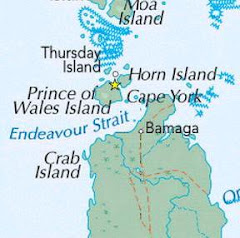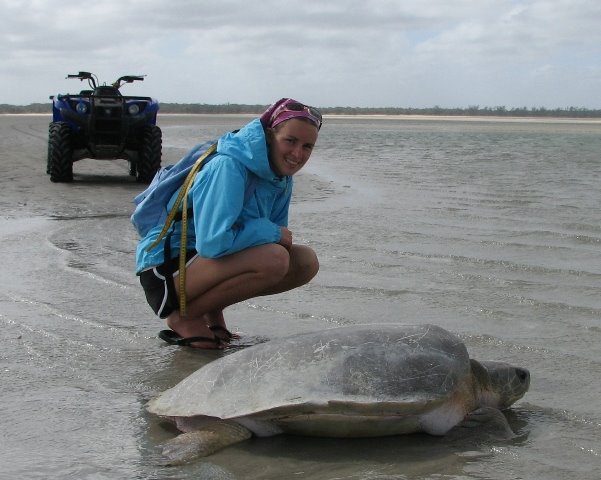
It would be easy to wonder how the flatback sea turtle is a threatened species seeing we have counted over 4500 turtles since our arrival. However, while it would be great to say the species is stable, the reality is there are a number of factors which make them vulnerable to extinction. The numbers we are seeing are probably only a proportion of what was a much wider and larger nesting population. Crab Island is possibly a remnant of what was once a population which nested right down the west coast of Cape York.
The fact is Crab Island supports the majority of nesting females for the entire species and seeing so many comes as no surprise. We are at the peak of the nesting season, seeing the majority of females. To put things into perspective, when you compare Crab Island to other major Flatback rookeries, such as those in central Queensland, the Northern Territory and Western Australia, it is clear that Crab is the hotspot. These other rookeries support several hundred nesting flatbacks each year, with a combined total of several thousand. Crab on the other hand can support several hundred each night, and may have a nesting population of between 10,000-15,000 females.
What’s the fuss you may say? Well, while we know very little about flatback sea turtles, we do know they have suffered severely from various impacts in recent decades. For starters, the three decades from the mid 70’s saw intensive trawling effort in northern Australia and the Gulf of Carpentaria. This tripled in intensity by the mid 90’s before being regulated. During this period tens of thousands of sea turtles were trawled up each year and the majority of these were flatback sea turtles. The impact of this was not immediate, and we still probably haven’t seen the result of these activities. The reason being was that most of the turtles trawled were sub-adult turtles. This is important as sea turtles are a long lived species (they may live over 100 years, but no one has studied them long enough to know), and they may not mature until they are 35–50 years old. Therefore, a generation of turtles may have been severely depleted and we will not see that impact until at least next decade.
On top of this, feral pigs are destroying close to 100% of nests on the mainland. This means that no eggs are hatching and no turtles are being recruited back to the population. It is likely that turtles which lay on Crab, also lay on the adjacent mainland and make up one large breeding unit. No eggs hatching is bad enough. What makes this worse is that the evidence we have collected to date suggests that mostly females are born on the mainland and mostly males on Crab Island (sex of hatchlings is determined by sand temperature). Females are the most important aspect of the survival of any species – no females being recruited to the population is not a good thing.
Once again, the impact of feral pig predation on nests will not be seen for a couple of decades. All of a sudden there are several generations of turtles which will not be breeding. They will struggle, but they have survived since before the dinosaurs, through ice ages, etc, so they are a pretty tough species. They may survive and continue on, unless they were pushed to the edge by something major…
Climate Change - A threat in itself to the existence of sea turtles, and could certainly be the nail in the coffin when you look at the cumulative impacts on flatbacks. Sea turtles will be one of the first species impacted by climate change – they are very dependent on a stable temperature. For example, the sex of hatchlings is determined by the temperature of the nest during incubation. There is a pivotal temperature during incubation (around 27oC/80oF) – hotter than this it will produce females, colder and you get a male. But there is a small window which results in mortality – sand temperatures above 32oC/90oF or below 24oC/75oF will result in mortality. The reason that Crab Island supports so many nesting turtles is that the sand provides the right and stable temperature range for incubation. It’s not as simple as moving to a new nesting beach.
For a small island such as Crab, where a lot of turtles lay their eggs just above the high tide mark, sea level rise could also result in flooding of nests and high mortalities. It is unknown what higher sea temperatures will do to food resources and traditional feeding grounds.
Other factors which require investigating are some reports of flatbacks turning up in markets in Irian Jaya (Indonesia). Crab Island’s close proximity to the indigenous communities of Bamaga and Thursday Island also means that the traditional harvest of turtles and eggs remains unmonitored. The island is much more accessible these days with the use of outboard motors, rather than the traditional dug out canoes.
In addition, while the trawling activities in Australia’s northern waters have now been regulated with the introduction of mandatory ‘Turtle Exclusion Devices’ (TEDs), there is increasing illegal fishing in these waters. Having overfished their own waters, and with the rich abundance of fish stocks in Australian waters, it is tempting for illegal Indonesian fishing boats to plow the same waters in which flatbacks occur. Indeed, thousands of illegal fishing vessels enter these waters each year, overwhelming the customs vessels which patrol them. The catch of flatbacks remains unmonitored but is most likely high.
The other factor associated with illegal foreign fishing vessels is their habit of discarding or losing large fishing nets, sometimes miles long. These are known as ‘ghost nets’ and their impact should not be underestimated. Indeed on Crab Island there is a washed up ghost net at least every 100ft –and those are the ones you can see which have not been buried. These nets drift the oceans catching countless numbers of sea turtles and other marine life before being washed ashore. But the reason they are known as ghost nets is that when a storm hits they are normally washed back off the beaches and back into the oceans to catch more marine life.
The cumulative impact of these threats may be sudden and irreversible. Add to this other factors such as increased boat strike, increased tourism, pollution (we have identified for the first time fibropapilloma on flatbacks – a tumorous growth associated with poor water quality) and the fact that Crab Island remains unprotected. Simply, this means the flatback sea turtle is far from being safe and secure.
These are some of the main reasons why the flatback is listed as a threatened species. But all is not gloomy and we, personally, remain optimistic – the flatback’s range is mostly contained within Australian waters, unlike most other sea turtle species who are found globally and whose range may cross many international borders. This presents an opportunity for effective protection. Crab Island is still a remote location and this in itself provides a level of protection. However, Crab Island is too important a resource to not have any formal protective status over it. It is still open to interests such as mining or major tourism. The opportunity exists to secure the island for prosperity and to start to mitigate the major threats highlighted above throughout their range. But this has to start immediately, conservation strategies are long overdue.
The purpose of this study is to start to get a good understanding of the population dynamics of the breeding cohort of Crab Island’s flatbacks – are they decreasing, stable or increasing? At the moment it is unknown. Only a long term monitoring study will determine this, and conservation strategies can be better informed which will assist in halting any downward trends.





No comments:
Post a Comment